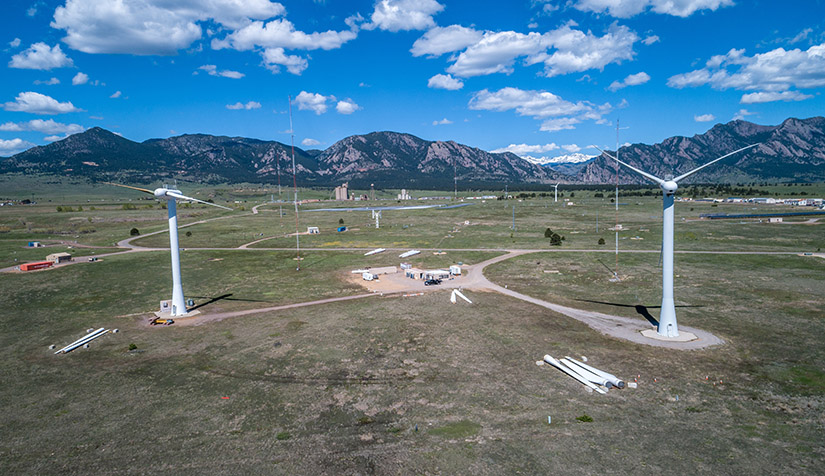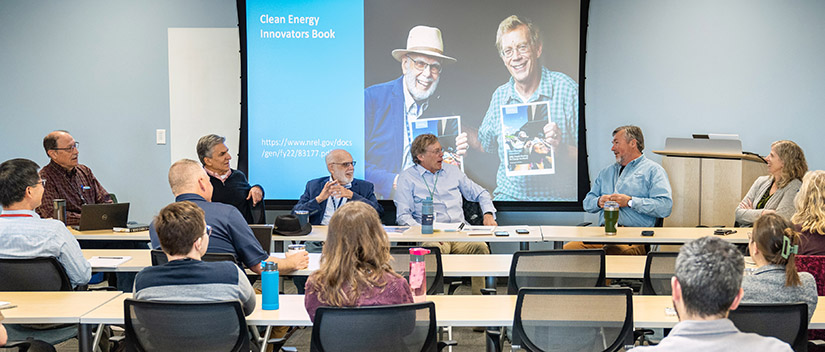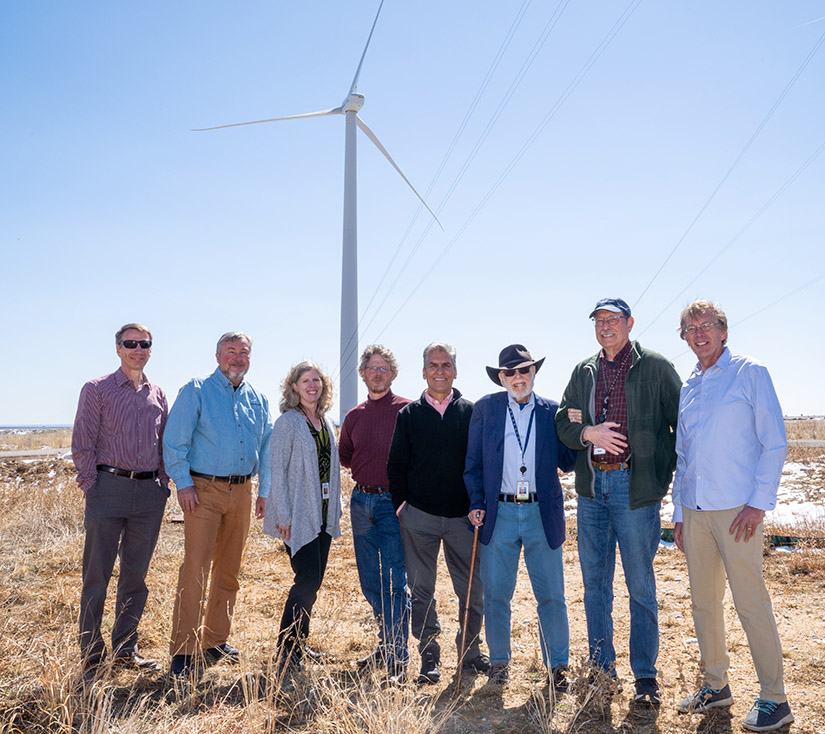The Winds of Change Keep Blowing
NREL Wind Pioneers Revisit the ‘Wild West of Wind’ and Look at Wind Energy’s Future

NREL’s Flatirons Campus near Boulder, Colorado, is central to the Wild West of wind research. Photo by Joshua Bauer, NREL
The stampede to harness wind for energy in the late 20th century was as frenzied as the California gold rush of the 1850s. And that explorer’s mindset persists today.
A panel of National Renewable Energy Laboratory (NREL) wind experts brought the wind mining comparison to life during an April 6 panel at NREL’s Flatirons Campus, expanding on the tales included in NREL’s Clean Energy Innovators book by Ernie Tucker.
The California wind boom was taking off because of federal and state tax incentives and alternative fuel mandates for Golden State utilities. It drew schemers, dreamers, and believers seeking to pluck the new gold from the air.
Among those who trekked to the Golden State was Brian Smith, now NREL’s wind laboratory program manager. He told the audience about his first day on the job as chief engineer at a wind farm in Palm Springs, California, in 1984 as a hungry 25-year-old engineer, driving a rusty Volkswagen Rabbit.
As Smith walked with his boss, surveying the site’s 100 "windmills" as he called them then, a shadow flashed over their shoulders. Soon after, another silhouette flew past them and spooked the rookie.
He recalled turning to his boss to ask what was going on. His boss shrugged, saying those silhouettes were from 20-foot-long fiberglass turbine blades that became airborne daggers once they spun off the turbine. Casually, he told Smith there were scheduled fixes to this potentially disastrous scenario—but the turbines needed to keep turning to produce revenue.
In those days of the Wild West, many machines failed. It was common to see turbines with blades spinning out of control, the runaways that could harm bystanders, as well as machines that crashed to the ground following a “big blow”—the term for windstorms.

Smith said he oversaw a variety of impromptu fixes, including purchasing a crossbow to shoot a rope attached to an arrow through the blades so that the rope would catch the blades and eventually slow down a runaway and stop it.
Likewise, Walt Musial, now an offshore wind expert who like Smith joined NREL’s predecessor, the Solar Energy Research Institute (SERI), in 1988, walked into a job in product support as an untested 25-year-old at Energy Services Inc. in Boulder, Colorado, but soon ended up as their man on wind farms in Altamont Pass in California.
With little or no safety training, and helmets being optional, Walt was often tasked with climbing up narrow metal ladders on turbines—once nearly fatally being dragged into a spinning turbine blade when a length of rope clipped to him caught in a rotor.
Runaways were not the only problems they faced. Gearboxes would break from the forces exerted on them, and the early wind machines were not well understood by the industry. Those wind miners "didn't know what they didn't know, but were willing to figure it out," said Sandy Butterfield, who came to SERI in 1986.
Butterfield had a jarring beginning at SERI when he met a local TV news crew on his first day. "My job is to talk to the press and add color. So, we arrived at sunrise with the whole camera crew ready to get these shots of this beautiful turbine. It was a French turbine, the Aerowatt," Butterfield said. "The turbine was on the ground, and that became our testing mode."
As he noted with a chuckle, "The first test was ‘Does it survive a windstorm?’ And at the time, 50% of them didn't." Failures, he said, of turbines, gearboxes, and other components, were the quickest ways to find out design weaknesses. Then it was back to the drawing board to try, try again.
"I think Walt and his team became one of the masters of destructive testing. They said, ‘Look, we don't test unless we can break the blade or break the gearbox,’" Butterfield said. "So, we love breaking gearboxes. I've been breaking gearboxes my entire life."
Other wind energy stalwarts joining the panel were NREL researcher emeritus Bob Thresher, Group Manager Amy Robertson, and Senior Research Fellow Paul Veers. National Wind Technology Center Director Daniel Laird and distributed wind researcher Ian Baring-Gould were also on hand to field questions. Communications Office writer Ernie Tucker moderated the informal presentation.
You can view the panel on NREL’s YouTube channel.
Much of the focus was on Thresher, whose upbeat spirit and humor infused the gathering.
Thresher reminisced about how he transitioned from a job as an Oregon State University professor to become a wind activist. The global oil embargo in 1973 made him want to enter the wind field.
"I sat in a gas station line for five or six hours, as many others did. I just didn't see any reason why we should depend on other people,” Thresher said. "It seemed like we should be able to produce our own energy, one way or another.” Thresher was lured to SERI in 1984, and he has been doing exactly that with wind and waterpower ever since.

The Future of Wind on the Horizon
Robertson, NREL’s first full-time offshore wind researcher, has been at NREL since 2010. Growing up, she said, she wanted to be an astronaut. But after a few nauseating rides on her dad's NASA gyroscopic flight simulator, she changed her goal to become a "lab rat."
"The day I was hired, they were like, ‘There's this new floating wind project happening. Why don't you figure that out, Amy?’ And it was the best opportunity ever, because I think floating wind is just like the craziest idea," Robertson said. "It’s a complex mechanical system out there that's just fascinating—engineering problems to solve. And fun."
And while the United States is moving ahead with fixed bottom turbines, it is also preparing for the next phase of offshore wind: floating wind turbines. Amy intends for NREL to be a world leader in that realm.
Veers, a senior research fellow who spent many years at Sandia National Laboratories before joining NREL in 2010, discussed his time working with all the panelists and others at NREL. Their approaches made all the difference in wind energy progress.
“I think this group up here are people who looked at the system. They didn't say, ‘I'm an aerodynamicist, [so] I'm going to solve an aerodynamics problem,’ or ‘I'm a gearhead, and I'm going to solve gear problems and work forward,’” Veers said. “They said, ‘What does this system need? What's the key problem here? What's the innovation that we must go forward?’ and looked at that.”
The discussion concluded with Bob Thresher sayings—including his own that he “teaches the young people old tricks, and they teach me new ones.”
The wind visionaries and others pursued and continue to pursue a crazy dream: to power the world with wind. The hourlong presentation can be seen on NREL’s YouTube page.
Clean Energy Innovators: NREL People Working to Change the World, a 202-page softbound book, can be downloaded for free and is aimed at the general public as part of NREL’s history webpage.
Last Updated May 28, 2025
